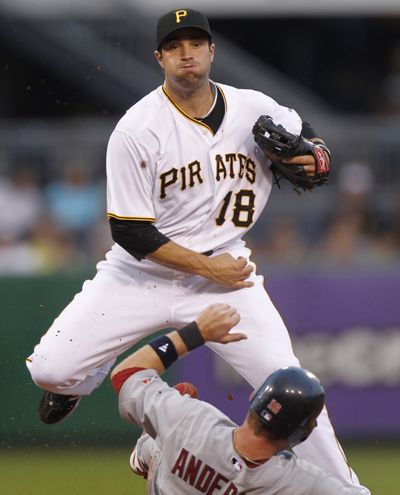Pittsburgh Pirates second baseman linked to Clemente
Walker’s dad loaded plane on fateful day

PITTSBURGH – When Pirates second baseman Neil Walker takes the field at PNC Park, he needs only to glance over his shoulder at the 21-foot Roberto Clemente Wall in right field for inspiration.
Walker, one of the majors’ top rookies, grew up in Pittsburgh hearing countless stories about one of baseball’s greatest outfielders and a man whose influence in his native Puerto Rico extends far beyond the diamond.
While Clemente died 13 years before Walker was born, the two will be forever linked by the night of Dec. 31, 1972 – when Clemente’s plane, jammed with relief supplies for Nicaraguan earthquake victims, crashed off the waters of San Juan. Walker’s father, Tom, was one of the last to see Clemente alive and had been minutes away from climbing aboard the plane himself.
“I can remember it like it was yesterday,” said Tom Walker, a major league pitcher for six seasons from 1972-77. “We left the airport, and it was the last time I ever saw Roberto Clemente. He saved my life by not letting me get on that plane.”
The elder Walker and fellow Expos pitching prospect Balor Moore were playing winter ball together on Clemente’s team, which featured mostly Pirates prospects. When the devastating earthquake struck, Clemente asked his fellow Puerto Ricans for help. So respected was Clemente, who only three months before had collected his 3,000th hit, that his countrymen responded by donating tons of food, clothing and medical supplies.
“There was so much stuff – there were donations everywhere at Hiram Bithorn Stadium, our ballpark,” Walker said. “Balor and (former Pirates catcher) Manny Sanguillen and myself helped load up the trucks and we went to the airport. We told Roberto we wanted to go with him, but there was a party on New Year’s Eve and he would absolutely not let that happen.”
The DC-7 was so filled with 16,000 pounds of supplies, Walker said, “there was hardly room for anything else, but by no means did Roberto think the plane was unsafe.”
The aging plane burst into flames shortly after takeoff and was never seen again, killing Clemente and four others. Sanguillen, one of Clemente’s closest friends, was so heartbroken he walked the beaches for days, searching for any sign of life.
Walker was saddened by the death of a man he greatly respected and was shaken by the realization he could have been on the plane himself.
“Winter baseball just stopped,” Walker said. “The Pirates sent down a planeful of players for a memorial service at a Catholic church, and there were a lot of tears. He really was a hero. He was a great humanitarian. He was so popular in Puerto Rico, he could have run for governor, but he knew better than that. His value was in helping people, and it cost him his life.”
Neil Walker has heard these tales from his father, and many others, and the two have made multiple visits to the downtown Pittsburgh sports museum that contains Clemente artifacts. A trip to the Hall of Fame in Cooperstown, N.Y., revealed Clemente’s full name is Roberto Clemente Walker; Walker was his mother’s maiden name. Tom Walker’s full name is the similar Robert Thomas Walker. That also made an impression on Neil Walker.
“Many of the younger players today are focused on the current players, but Neil knows stories of Roberto and Bill Mazeroski, who’s been an idol to Neil,” said Tom Walker, who once pitched a 15-inning no-hitter in Double-A. “Neil has a sense of the history of the game.”
So when Hall of Famer Mazeroski attended the Pirates’ spring training camp as an infield instructor, Walker asked for help – even though Walker was drafted as a catcher in 2004 and was playing third base at the time. Walker sensed the more positions he knew, the better off he’d be.
Mazeroski’s help proved invaluable earlier this season when the Pirates, realizing that Aki Iwamura wasn’t working out at second, hastily asked Walker to learn the position. Walker played barely a dozen games there at Triple-A, yet has been an above-average fielder while hitting .310 with nine homers and 49 RBIs since his May 25 callup.
Walker is one of the N.L.’s hottest hitters, going 16 of 36 (.444) since Aug. 24. .
“The better you do here, the more confidence you build,” Neil Walker said. “You’re definitely rewarded in this sport for how much you can take, especially mentally, because this game will run you down and humble you quickly.”
He learned that while being switched from position to position in the minors. Walker also had a difficult time convincing the Pirates he was an everyday player; they thought as recently as spring training he might be a utility man at best. It also didn’t help that he was drafted by the former Pirates regime, not the current one.
Once he reached the majors, Walker realized he belonged.
His father, who pitched in the majors for six seasons, is an inspiration. So is the giant shadow cast by the Clemente wall.
“I think I have a good perspective on how the game needs to be played,” Walker said.